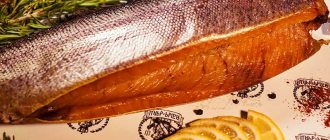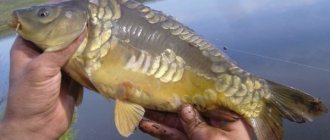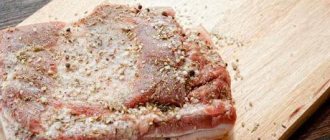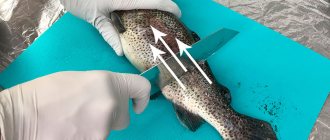Carp is an appetizing river fish with small scales that must be removed by cleaning. This fish requires gentle handling, so many people have a question: how to clean carp? Here we need a system that takes into account all the subtleties and difficulties that may arise during the work process.
When cleaning a carcass is carried out in the kitchen of an apartment or in a house, then after that it takes a lot of time and effort to wash the work area of scales, since they scatter in all directions. But this can be avoided.
Cleaning tool
Typically, a standard kitchen knife is used to clean carp. For people who have not encountered this seemingly complex matter, it is better to use a dull knife, spoon or fork. There are also special tools on sale - scrapers for cleaning fish. They are very convenient to use.
You can also use a special grater that you make yourself for this work. Tin beer caps are nailed to a wooden board. A good grater will be made from a tin can with holes in the bottom, punched with a nail.
Advice
To free the carcass from scales, it is better to purchase a vegetable peeler with a longitudinal blade. It will make the task easier and make the work quicker. To clean larger and larger specimens, it is better to use the bathroom. The peeler should be separate and used only for cleaning fish.
Cleaning carp from scales and entrails
After preparing the work area, you can clean the carp from scales. Pour water into a deep bowl and place the fish in it. First put rubber gloves on your hands and rag gloves on them so that the carcass does not slip. Using a grater and a fish scraper, remove scales, moving from the tail to the head.
After cleaning, rinse the fish. If there are any problem areas, pour boiling water over them. Hot water will soften the plates and they will easily come away from the skin. To quickly clean small carp, you can completely immerse the carcass in boiling water for 30–50 seconds.
Rip open the abdomen from the anus to the head using a sharp kitchen knife. Do not make the incision deep so as not to damage the intestines. Use a knife to scrape out the insides, being careful not to damage the bile sac. Remove all films and blood clots. Rinse the carcass thoroughly several times under running water.
If the bile was cut during the tearing process, you need to quickly place the carcass under running water to wash away all remaining bitterness. On the back, make deep cuts on the sides of the upper fin and pull it out. Use scissors to cut off the sides of the fins. Also make cuts at the bottom near the tail to remove the lower fin.
Preparation
First of all, the carp needs to be rinsed under cold water, thoroughly wetting the scales. Then get to work immediately so that the scales do not have time to dry, otherwise the cleaning process will be slow and difficult.
Hard scales that adhere closely to the skin will not be easy to remove. It is better to immerse such fish in boiling water for a few minutes, the main thing is not to overdo it.
To avoid injury from the hard fins during the procedure, they must be removed by cutting them with kitchen scissors.
Advice
Fresh fish must be kept in the refrigerator, without leaving it on the table for too long. After purchasing it, you need to immediately remove all the insides and gills, since this is where bacteria multiply. Before placing the carp in the refrigerator, it must be washed and dried with a paper towel.
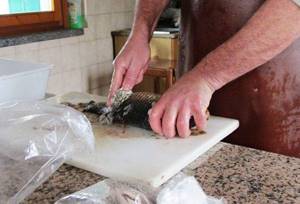
Features and value of carp
Carp is an artificially bred species of fish, the ancestor of which is the carp. The word "carp" comes from the Greek language and is translated as fruit. And for good reason: one female produces up to 1.5 million eggs. The Chinese were the first to breed domesticated carp. Historians believe that this fish began to be used as food back in 1000 BC. e. Carp dishes became a favorite treat for Chinese emperors. Later, fish began to be bred in other Asian countries and Europe.
Carp meat has great benefits for the body. It is very tender and sweetish in taste. The fat content of fish muscle tissue is lower than that of lean beef, which is important for people on a low-fat diet, as well as for children and athletes. Carp is a source of many important nutrients, proteins and omega-3 fatty acids. These unsaturated acids have a positive effect on cardiac function and help prevent cardiovascular diseases. Another feature of carp is its ease of digestibility, due to the special structure of muscle fibers.
It takes three or four years to grow carp in artificial reservoirs. Three-year-old individuals reach a weight of about 2 kg, and four-year-old individuals weigh more than 2.5 kg.
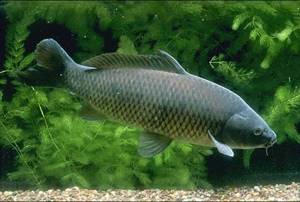
Carp is a domesticated form of carp
Varieties of carp - gallery
Tips for choosing quality fish
- Fresh carp is easier to clean. If you buy fish in a store or market, try to take it from an aquarium. You can kill it with a strong blow to the head at a point located slightly above eye level, or simply by cutting off the head (if you are not going to bake the whole carp). There is a more humane way to kill fish - put it in the freezer for an hour and it will fall asleep.
- If you do not have the opportunity to buy live fish, it is better to choose fresh chilled fish, since frozen fish loses a large amount of minerals when thawing. When purchasing fresh fish, choose a specimen with the head on. This is the only way you can be sure of its freshness.
- Before buying, look into the eyes of the fish: fresh ones should be bright, slightly moist and convex.
- Be sure to inspect the gills and choose a specimen with clean, bright, and red gills.
- The body of fresh fish is quite elastic, without white coating or dried crusts, and the tail should hang freely from the palm.
- When purchasing frozen carp, pay attention to its glaze. If the fish was properly frozen and stored under all necessary conditions, the glaze on it should be smooth, without cracks. If the carp was frozen using dry freezing, then the carcass should be smooth and hard, without ice.
It is best to thaw frozen fish in water at room temperature. To reduce the loss of minerals during thawing, add table salt to the water (7-10 g per 1 liter of water).
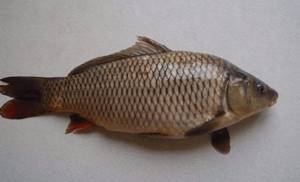
The eyes of fresh fish should be bulging and slightly moist, and the carcass should be elastic, without white coating or dried crusts.
How to clean fish from scales?
The main question that arises in the process of processing carp is what to do to prevent the scales from flying off in different directions?
- Many people clean fish by dipping it in a bowl of water. The scales remain in the water and do not need to be removed later.
- You can put the carcass in a thick plastic bag and clean it there. All waste will remain inside the bag.
- The carcass can be cleaned on the table by nailing it by the tail to a wooden cutting board. The fish is pulled out, held by the head, and calmly cleaned, starting from the tail, against the growth of the scales. However, after this procedure you will have to wash the table and kitchen utensils.
We recommend: Are nuts washed only by clean people or is it really necessary?
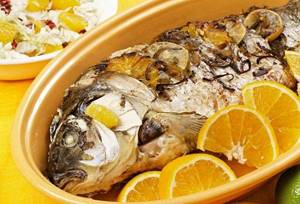
Preparing fresh fish
If you bought carp from an aquarium in a store, ask the sellers to properly cut the live carp. They provide such a service. When you bring home an uncut carcass, it is covered in mucus. It is difficult to hold such an individual in your hands. Rinse it under water - problem solved. Also, the water will soak the scales, making it easier to remove. If you get a large representative, pour boiling water over it. Be sure to cut off the fins before you begin removing the scales. They are sharp and can injure your hands. You are lucky if you choose a mirror carp; it is not completely covered with scales and is easy to clean.
Removing scales
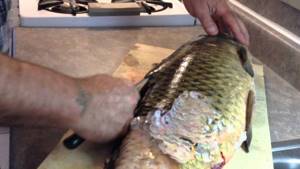
We begin to remove the stratum corneum. Use the tools we talked about earlier. To prevent scales from flying all over the kitchen, fill a sufficiently sized container with water and carry out the procedure in it. You can protect your kitchen with a regular bag. Place the fish in a bag. Work so that the debris remains inside the cellophane.
Attention! Dip the carcass in boiling water for no more than one minute; you can quickly clean it.
For adherents of traditional methods, you can simply place the fish on a cutting board and clean off the scales with a knife from the tail to the head; at the end of the work, do not forget to wash the kitchen well.
How to clean a carcass from scales using the “removal of chain mail” method
Prepare a sharp butcher (with a long blade). Use it to pry the scales at the base of the tail, but do not damage the skin. Cut off the scales by moving the tool towards the head. In the place near the head where the scales are connected to the bone, make a cut - this is how you get chain mail. Do the same on the other side.
How to gut a carcass
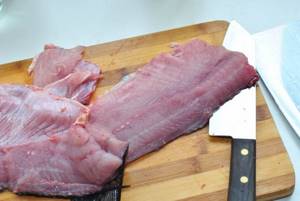
The next step is to cut it correctly. Make an incision in the belly and carefully remove the contents. Do not damage the gallbladder, otherwise the meat will become bitter. The abdominal cavity is covered with a dark film - you need to clear the pulp from it. Now you can cut off the head and wash the carp. The fish is now ready for filleting. Cut the meat along the spine, but do not damage the ribs. Place the knife under the ribs and separate the pulp. Cut the fillet from the tail.
How to cut fins
It’s not difficult to cut off the fins without getting pricked by them. You need to make a couple of cuts on the sides and cut out the fin. Pull out the ones on the sides with your fingers. To remove the lower ones, you will need long cuts on both sides. Start cleaning while the fish is fresh. Frozen carp are difficult to clean.
Carp processing process
- After the cleaning process, the fish must be gutted. The carcass is placed belly up and opened with a sharp knife from head to tail.
- Then all the entrails and the brown film inside the abdomen are removed. Depending on the type of future dish, the head of the fish is either removed completely or the gills are pulled out of it.
- The fish is thoroughly washed and the preparation of the dish begins.
- After finishing the treatment process, the surface of the kitchen table and all kitchen utensils must be thoroughly washed with a cleaning agent, or better yet, scalded.
Fresh carp is easier to clean. Having brought home a fish you bought or caught with your own hands, you should not put it in the freezer; it is better to immediately begin this not very pleasant, but necessary process.
We recommend reading the following article: how to clean trout
Features of carp
Carp is an unpretentious fish and can be caught using almost any bait. It can be attracted either by corn or peas, or by worms or maggots. Before preparing a dish, it is imperative to remove the bait from the mouth so that it does not end up in the finished dish.
To remove the bait, you need to open the carp's mouth and expose it to a fairly high pressure of cold water. Thus, the water will wash away all excess. If you can’t get the bait, then you can use a hook.
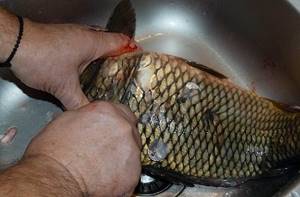
Before you start cleaning the carp, you should rinse it and remove any remaining bait.
If the dish will be prepared without the head, you don’t have to waste time on this, but simply cut it off.
Cleaning and cutting of carp
Currently, a huge number of recipes for cooking carp have been invented. It is baked with a side dish of vegetables, potatoes and cereals, and also boiled with spices, stuffed in various ways and simply fried in vegetable oil until crispy. On store shelves you can find gutted frozen fish, fillets and ready-made semi-finished products. But you'll get the most benefit from fresh or live carp. Don't be afraid of the upcoming hassle with cutting the fish. Having mastered a few simple rules, you can easily turn live carp into a culinary masterpiece.
The most common carp on sale are common and mirror carp. The latter is a little easier to clean, due to the fact that its scales are large and not very tightly pressed to each other. With common carp you will have to tinker a little longer.
What you need for work
To properly and easily clean and cut fish you will need the following tools:
- sharp knife for cutting fish;
- fish scissors;
- scraper for cleaning fish, you can use a spoon.

To make the process of cleaning and cutting carp easier, purchase the necessary tools: a - sharp knife, b - scissors, c - scrapers
You also need to prepare:
- a plastic bag or bucket for bones and other debris;
- thick paper or newspaper;
- work gloves.
Step-by-step instructions for cleaning, gutting and cutting carp
- Cover the table with thick paper or newspaper. The paper will absorb the liquid that the fish will release during cutting and prevent contamination of the workplace. Some housewives prefer to clean and cut fish directly in the sink, after closing the drain with a special silicone or metal mesh.
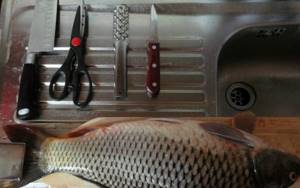
Some housewives clean and cut fish in the sink
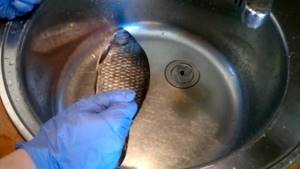
To prevent the fish from slipping out of your hands, wear work gloves
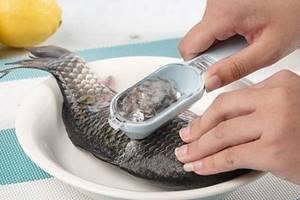
Remove scales using a scraper

Cut the carcass along the belly and remove the entrails
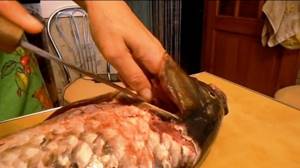
Remove the head or take out the gills
